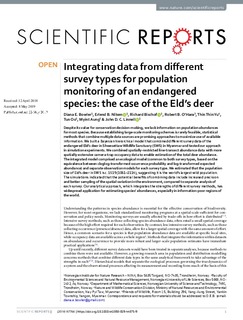| dc.contributor.author | Bowler, Diana Elizabeth | |
| dc.contributor.author | Nilsen, Erlend Birkeland | |
| dc.contributor.author | Bischof, Richard | |
| dc.contributor.author | O'Hara, Robert B. | |
| dc.contributor.author | Yu, Thin Thin | |
| dc.contributor.author | Oo, Tun | |
| dc.contributor.author | Aung, Myint | |
| dc.contributor.author | Linnell, John Durrus | |
| dc.date.accessioned | 2019-10-04T09:09:50Z | |
| dc.date.available | 2019-10-04T09:09:50Z | |
| dc.date.created | 2019-05-28T13:10:55Z | |
| dc.date.issued | 2019 | |
| dc.identifier.citation | Scientific Reports. 2019, 9 . | nb_NO |
| dc.identifier.issn | 2045-2322 | |
| dc.identifier.uri | http://hdl.handle.net/11250/2620255 | |
| dc.description.abstract | Despite its value for conservation decision-making, we lack information on population abundances for most species. Because establishing large-scale monitoring schemes is rarely feasible, statistical methods that combine multiple data sources are promising approaches to maximize use of available information. We built a Bayesian hierarchical model that combined different survey data of the endangered Eld’s deer in Shwesettaw Wildlife Sanctuary (SWS) in Myanmar and tested our approach in simulation experiments. We combined spatially-restricted line-transect abundance data with more spatially-extensive camera-trap occupancy data to enable estimation of the total deer abundance. The integrated model comprised an ecological model (common to both survey types, based on the equivalence between cloglog-transformed occurrence probability and log-transformed expected abundance) and separate observation models for each survey type. We estimated that the population size of Eld’s deer in SWS is c. 1519 (1061–2114), suggesting it is the world’s largest wild population. The simulations indicated that the potential benefits of combining data include increased precision and better sampling of the spatial variation in the environment, compared to separate analysis of each survey. Our analytical approach, which integrates the strengths of different survey methods, has widespread application for estimating species’ abundances, especially in information-poor regions of the world. | nb_NO |
| dc.language.iso | eng | nb_NO |
| dc.publisher | Nature | nb_NO |
| dc.relation.uri | http://hdl.handle.net/11250/2599428 | |
| dc.rights | Navngivelse 4.0 Internasjonal | * |
| dc.rights.uri | http://creativecommons.org/licenses/by/4.0/deed.no | * |
| dc.title | Integrating data from different survey types for population monitoring of an endangered species: the case of the Eld’s deer | nb_NO |
| dc.type | Journal article | nb_NO |
| dc.type | Peer reviewed | nb_NO |
| dc.description.version | publishedVersion | nb_NO |
| dc.subject.nsi | VDP::Zoologiske og botaniske fag: 480 | nb_NO |
| dc.subject.nsi | VDP::Zoology and botany: 480 | nb_NO |
| dc.source.pagenumber | 14 | nb_NO |
| dc.source.volume | 9 | nb_NO |
| dc.source.journal | Scientific Reports | nb_NO |
| dc.identifier.doi | 10.1038/s41598-019-44075-9 | |
| dc.identifier.cristin | 1700867 | |
| dc.relation.project | Norges forskningsråd: 251112 | nb_NO |
| dc.description.localcode | Open Access This article is licensed under a Creative Commons Attribution 4.0 International License, which permits use, sharing, adaptation, distribution and reproduction in any medium or format, as long as you give appropriate credit to the original author(s) and the source, provide a link to the Creative Commons license, and indicate if changes were made. | nb_NO |
| cristin.unitcode | 194,63,15,0 | |
| cristin.unitname | Institutt for matematiske fag | |
| cristin.ispublished | true | |
| cristin.fulltext | original | |
| cristin.qualitycode | 1 | |

